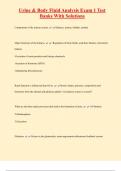-
1. Exam (elaborations) - Dnp pharmacology-genitourinary, contraception, and hrt practice questions and answe...
-
2. Exam (elaborations) - Chapter 15 - ensuring quality care questions and answers
-
3. Exam (elaborations) - Chapter 15 ensuring quality care questions and answers
-
4. Exam (elaborations) - Nn_15 ensuring quality care questions and answers
-
5. Exam (elaborations) - Urinalysis and body fluids final exam questions with solutions
-
6. Exam (elaborations) - Urinalysis and body fluids final exam questions with solutions
-
7. Exam (elaborations) - Urinalysis and body fluids final exam review
-
8. Exam (elaborations) - Urinalysis and body fluids final exam review questions with solutions
-
9. Exam (elaborations) - Urine & body fluid analysis exam 1 questions and answers
-
10. Exam (elaborations) - Urinalysis and other body fluids exam simulator questions and answers
-
11. Exam (elaborations) - Urinalysis and body fluids-quiz #2 questions and answers
-
12. Exam (elaborations) - Urinalysis and body fluids- success urinalysis and body fluids- success questions an...
-
13. Exam (elaborations) - Urinalysis and body fluids review questions and answers
-
14. Exam (elaborations) - Urinalysis and body fluids: quiz/exam questions modules 1-4 questions and answers
-
15. Exam (elaborations) - Urinalysis and body fluids exam 1 questions with solutions
-
16. Exam (elaborations) - Urinalysis and body fluids comprehensive exam questions with solutions
-
17. Exam (elaborations) - Urinalysis and body fluids: chapter 7 renal disease exam questions with solutions
-
18. Exam (elaborations) - Urinalysis and body fluids: ch 2 questions with solutions
-
19. Exam (elaborations) - Urinalysis and body fluids! questions with solutions
-
20. Exam (elaborations) - Urinalysis and body fluids questions with solutions
-
21. Exam (elaborations) - Urinalysis and body fluids questions with solutions
-
22. Exam (elaborations) - Urinalysis & body fluids questions with solutions
-
23. Exam (elaborations) - Urinalysis and body fluids exam 1 chapter 1-5 questions with solutions
-
24. Exam (elaborations) - Urinalysis and body fluids exam 1 questions with solutions
-
25. Exam (elaborations) - Urinalysis and body fluids amt questions with solutions
-
26. Exam (elaborations) - Urinalysis and body fluids (chapter 2) questions with solutions
-
27. Exam (elaborations) - Urinalysis and body fluids - chapter 15: amniotic fluid questions with solutions
-
28. Exam (elaborations) - Urinalysis and body fluids ch. 10-15 test review questions with solutions
-
29. Exam (elaborations) - Urinalysis and body fluids ch 12, 13, 14, 15 exam questions with solutions
-
30. Exam (elaborations) - Urinalysis and body fluids: ch 5 questions with solutions
-
31. Exam (elaborations) - Urinalysis and body fluids: ch 4 questions with solutions
-
32. Exam (elaborations) - Urinalysis and body fluids: ch 3 questions with solutions
-
33. Exam (elaborations) - Urinalysis and body fluids- ch 1 questions with solutions
-
34. Exam (elaborations) - Urinalysis and body fluids certification questions with solutions
-
35. Exam (elaborations) - Body fluids midterm exam – urinalysis test banks with solutions
-
36. Exam (elaborations) - Certification exam: urinalysis and body fluids test banks with solutions
-
37. Exam (elaborations) - Chapter 7 urinalysis and body fluids banks with solutions
-
38. Exam (elaborations) - Boc urinalysis / body fluids questions with solutions
-
39. Exam (elaborations) - Urinalysis and body fluid practicum questions with solutions
-
40. Exam (elaborations) - Aab mt exam chem urinalysis & body fluids questions with solutions
-
41. Exam (elaborations) - Urinalysis and body fluid final exam questions with solutions
-
42. Exam (elaborations) - Ascp urinalysis and body fluids
-
43. Exam (elaborations) - Boc urinalysis / body fluids test banks with solutions
-
44. Exam (elaborations) - Body fluid and urine analysis ch 2-4 test banks with solutions
-
45. Exam (elaborations) - Urinalysis & body fluids exam 1 (chapters 1,4,3) test banks with solutions
-
46. Exam (elaborations) - Urinalysis & body fluids exam 1 review test banks with solutions
-
47. Exam (elaborations) - Chapter 16 urinalysis, body fluids, and other specimens test banks with solutions
-
48. Exam (elaborations) - Cls urinalysis & body fluids test banks with solutions
-
49. Exam (elaborations) - Exam 2: urinalysis and body fluids test banks with solutions
-
50. Exam (elaborations) - Mlab1311 urinalysis and body fluids: final exam test banks with solutions
-
51. Exam (elaborations) - Mls review- urinalysis and body fluids test banks with solutions
-
52. Exam (elaborations) - Mlt ascp practice questions: urinalysis & body fluids test banks with solutions
-
53. Exam (elaborations) - Boc urinalysis & body fluids test banks with solutions
-
54. Exam (elaborations) - Urinalysis & body fluids ch. 1 test banks with solutions
-
55. Exam (elaborations) - Urinalysis and body fluids 6th edition chapters 1-6 test banks with solutions
-
56. Exam (elaborations) - Urine & body fluid analysis exam 1 test banks with solutions
-
57. Exam (elaborations) - Urinalysis & other body fluids test banks with solutions
-
58. Exam (elaborations) - Urinalysis and body fluid exam 1 study guide mr. turner class test banks with soluti...
-
Show more




